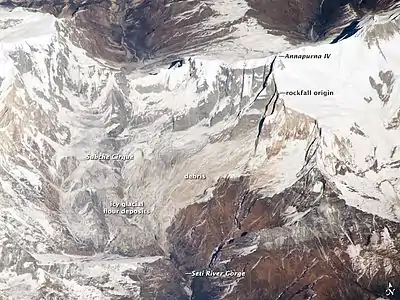Seti Gandaki River
The Seti Gandaki River, also known as the Seti River or the Seti Khola, is a river of western Nepal, a left tributary of the Trishuli River. Its gorges around Pokhara are a major attraction for tourists worldwide.
| Seti Gandaki | |
|---|---|
 Seti Gandaki from Ramghat Pokhara | |
| Physical characteristics | |
| Source | |
| • location | Slopes of Annapurna |
| Basin features | |
| River system | Gandaki River |
Geography
It rises from the base of the Annapurna massif, and flows south and south-east past Pokhara and Damauli to join the Trishuli River near Devghat.
The lakes of Pokhara were created through a geological process. As the Seti river carried the moraine from Annapurna Himalayas after the burst of glacial lakes at various pre-historical time periods, the moraine were deposited on the routes of the rivers. This caused formation of natural lakes.
Cultural and Religious Significance
Seti is one of the holiest rivers of Nepal, worshiped in Hinduism as a form of Vishnu. The river is also famous because it is close to some Holy places and is the central point of many stories of Hindu mythology, such as the Mahabharata, one of longest books of Hinduism, written by Vyasa, who was born near the confluence of the Gandaki and Madi rivers near Damauli, Tanahun, Nepal. Gandaki River .[1]
Gorges
Tributaries
Its major tributary are Mardi Khola, Kali khola, Phedi khola, Bijayapur khola, Khudi khola, Pudi khola, Suraudi khola, Bange khola and the largest tributary Madi. Pokhara, Leknath, Suklagandaki, Bhimad and Damauli are the cities through which Seti river flows .[2]
Exploration
The Seti Gandaki was successfully descended for the first time in June 1971 by Daniel C. Taylor and Jennifer Ide. They went by raft, having to portage around the three kilometer section where the whole Seti river goes underground.[3]
May 2012 Flood
A a slurry of sediment, rock, and water suddenly surged through Pokhara Valley on May 5, 2012, obliterating dozens of homes and sweeping 72 people to their deaths.[4][5]
Pollution
Dams
Bridges
KI Singh Pul
Manipal Suspension Bridge
Naraynathan Bridge
Seti Nadi Pul - span 180m
Dhunge Sanghu (natural bridge)
Gallery
 Gurung Museum, Pokhara
Gurung Museum, Pokhara view of Seti River from Tanahun
view of Seti River from Tanahun तनहुँ दुलेगौंडाबाट देखिने सेती
तनहुँ दुलेगौंडाबाट देखिने सेती The rockfall that temporarily blocked the river[6]
The rockfall that temporarily blocked the river[6]
References
- Negi, Sharad Singh. Himalayan rivers, lakes and glaciers. p. 64. Google books. Retrieved 2013-05-09.
- BBC News, 6 May 2013
- Daniel Taylor-Ide "Something Hidden Behind the Ranges" (San Francisco: Mercury House Press, 1995)
- "Making Sense of Nepal's Seti River Disaster".
- "Notes from the Field - One Scientist's Search for the Causes of the Deadly Seti River Flash Flood". earthobservatory.nasa.gov. 2014-01-24. Retrieved 2020-06-17.